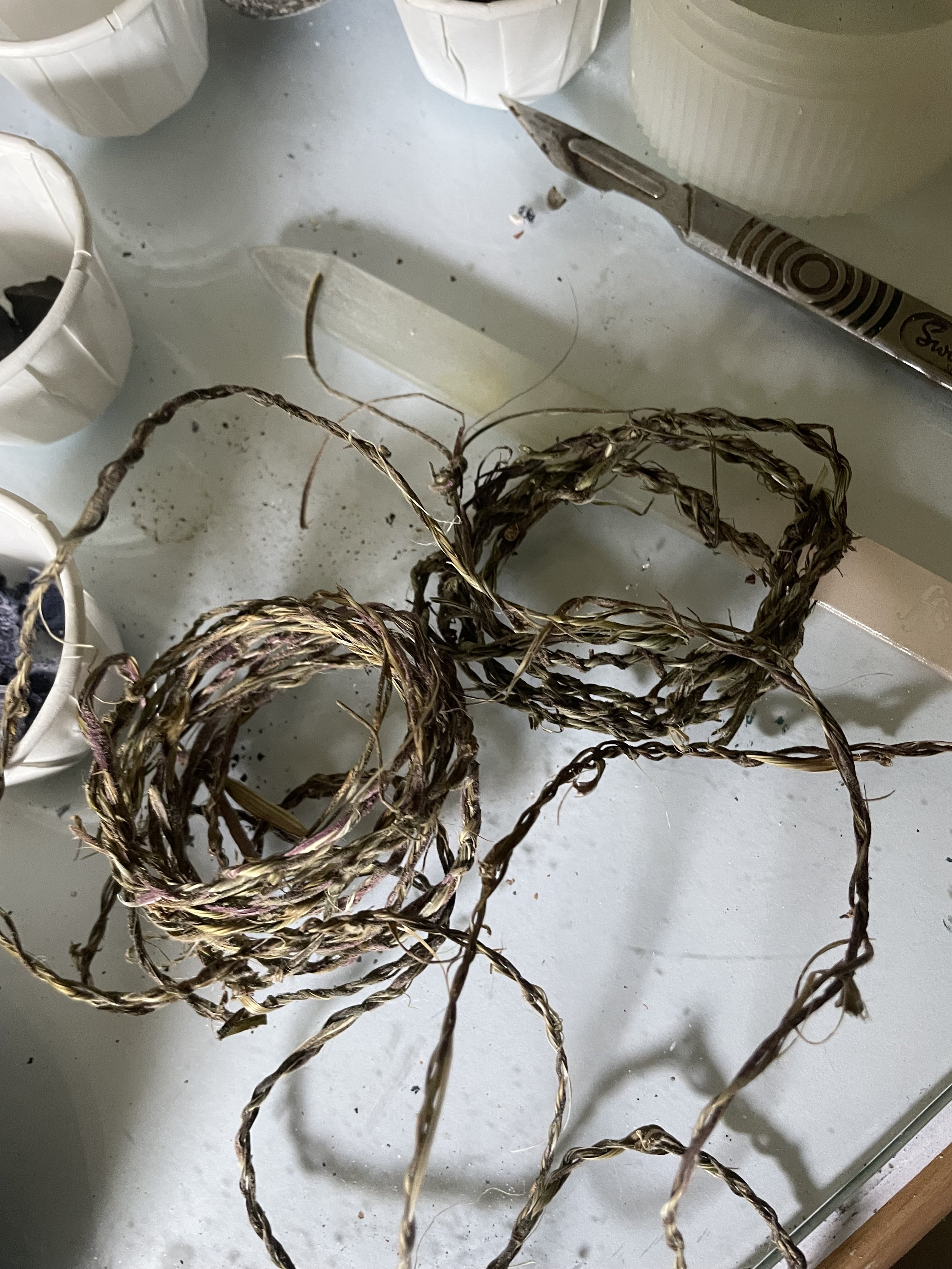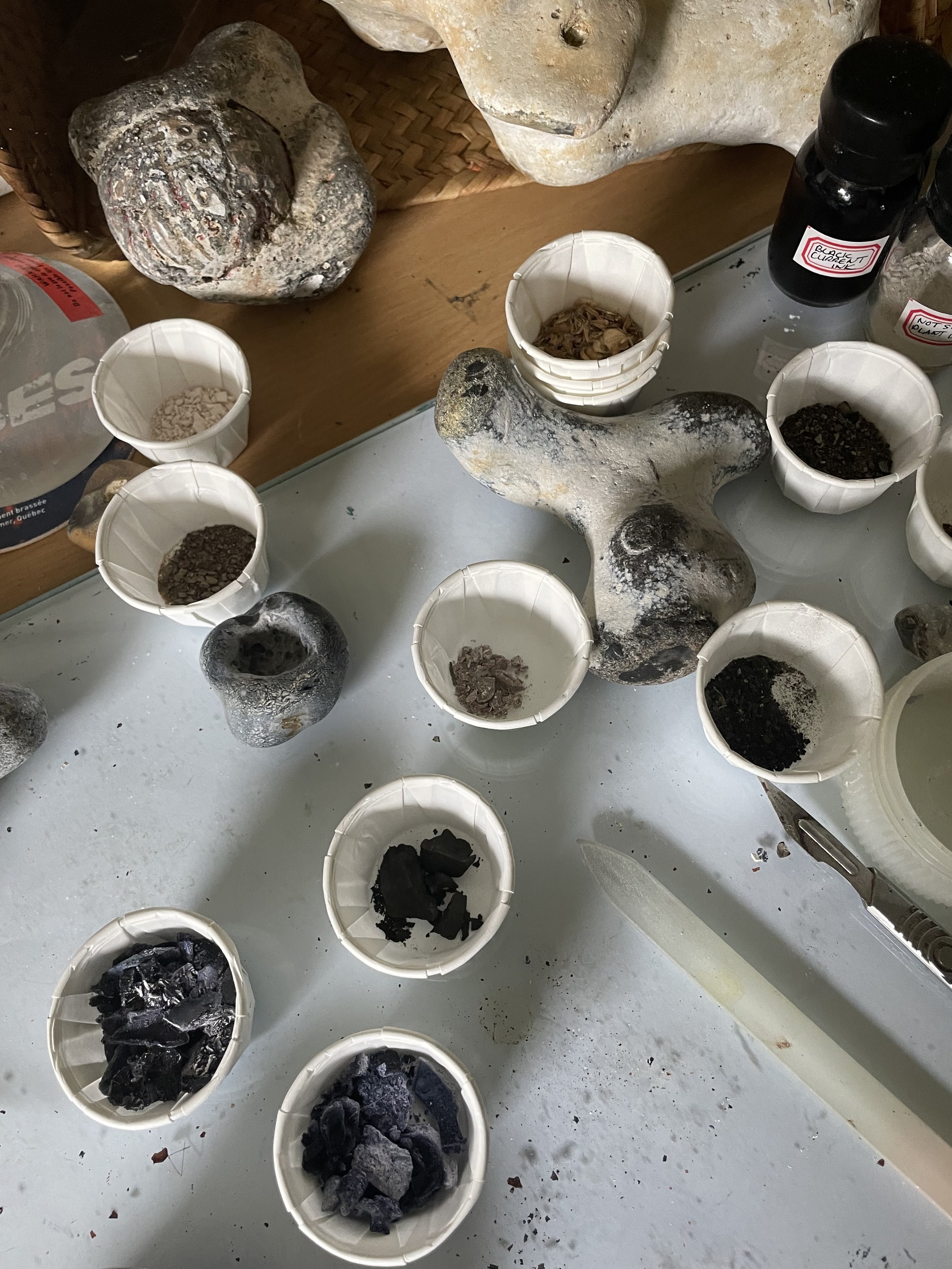Accumulation…
As I sit in my bedroom/studio on a wet Sunday afternoon, I ponder all the stuff around me, piles of rocks, plant matter, naturally made inks and powers, jars of stuff, seed, feathers, wool, living and dead matter, I begin to wonder: why? And where is this going?
one of three studio table covered in stuff!!
As a self-proclaimed "collector," a term I cautiously embrace, I'm often challenged by the whisper of my inner voice (and perhaps by others) labeling me more as a "hoarder." This internal debate brings me to the question: Where does this compulsion to collect come from? My thoughts inevitably turn to my late mother, who was without a doubt, a hoarder. Yet, where does this instinct to accumulate, organise, and save for the future originate? And why do some people seem completely immune to it?
Upon reflecting, I believe I’ve found my answer—but let me take you on the journey that led me here.
Growing up, my mother would take us to car boot sales and charity sales—long before the days when charity shops became commonplace. This was the late 70s and 80s when "bargain hunting" hadn’t yet become mainstream. For her, it was about survival and ingenuity. She sought out items she could reuse clothes that could be altered for me, my brother, or herself, toys that could be saved for birthday and Christmas presents, or materials she could repurpose into useful gifts or household items. If my mother were alive today, I’m certain she would have embraced the modern crafting and recycling movements. She was, after all, a pioneer of upcycling long before it was a trend.
Each year, a ritual emerged: fruit-picking to make jam and, more often, wine. But we never thought of it as "foraging" like people do now. For us, it was simply a necessity—money was tight, and we made the most of what nature provided.
As my mother entered her 40s and 50s, illness began to slow her down. By then, we had all moved out, and she no longer needed to make things for us. The 90s and early 2000s were marked by the rise of a "throwaway society" where mass-produced items became cheaper, largely due to imports. Despite her declining health, my mother's impulse to collect persisted, though her focus shifted to objects of little monetary value, like ornaments she believed would hold value someday. Her seamstress background kept her holding onto fabric, sewing machines, and supplies as if she might return to her craft—but she never did.
When she passed away at 53, we faced the overwhelming task of emptying her house—a three-story Victorian terrace brimming with accumulated items. Ornaments, fabrics, tools, clothing, and furniture filled every room. She never allowed anyone to enter her rooms unsupervised, so we had no idea of the true scale of her collection. Sorting through it all was an emotional burden; we felt she had wasted so much time and money. It led me to wonder: Was this an illness? A form of boredom? Or was it something deeper—an inexplicable drive she didn’t fully understand or articulate?
Now, here I am in my 50s, reflecting on her legacy and my relationship with collecting. Over the years, I’ve felt the same pull to gather and accumulate. Yet, I’ve always kept my mother’s experience at the forefront of my mind, vowing never to let my collecting spiral out of control. As a result, I’ve made a point to declutter religiously, embracing a "spring and autumn clear-out" as a kind of ritual cleansing.
During this time, I also retrained as an artist—a journey that led me to an interesting discovery. Every artist I’ve encountered, whether intentionally or not, seems to collect something. It’s as if gathering and collecting are inseparable from the creative process itself.
My artistic practice has undergone several transformations, moving from craft to traditional art, to conceptual work, politics, sculpture, painting, photography—you name it. I realize now that I’ve amassed not just objects, but a collection of interests and disciplines. In recent years, my work has become more ephemeral, focusing on nature, ecology, and womanhood. This shift has reignited my love for foraging (another form of collecting), but with a focus on reducing my environmental footprint, using only what is sustainable and necessary.
At the start of this reflection, I asked: "Where does this need to collect, store, and gather for the future come from, and why don’t others share this drive?" I believe the answer lies in language and history. Words like "foraging," "gathering," and "hunting" hark back to a time when survival depended on these activities. Historically, it was often women who took on the role of hunter-gatherers, foraging not only to feed their families but to heal their communities. These were collective efforts, driven by necessity, and passed down through generations.
I believe this primal instinct still exists in some of us, encoded in our DNA. For those of us who feel the urge to collect and prepare, this impulse may be a remnant of our ancestral roles. In today's world, where survival is no longer dependent on foraging and gathering, this instinct manifests in other ways—like collecting, hoarding, and nesting. It’s a way of readying ourselves for an uncertain future, even if we can’t fully explain why.
The Psychology of Collecting and Hoarding
Scientific studies offer intriguing insights into why some people feel compelled to collect while others do not. Research into hoarding disorder, for instance, suggests that this behaviour can sometimes be linked to anxiety or trauma. According to the International OCD Foundation, hoarding often develops as a way for individuals to manage emotional distress by creating a sense of control through possession. This contrasts with more benign collecting, which typically brings joy and satisfaction. However, the lines between collecting and hoarding can blur, particularly when emotional attachment to objects becomes overwhelming.
Interestingly, collecting itself can be seen as an extension of human nature. Psychologist Randy Frost, an expert in hoarding and collecting, notes that humans have always accumulated things, dating back to prehistoric times when stockpiling resources was essential for survival. The impulse to collect may be hardwired into us, a lingering remnant of when the gathering was necessary for human life. In modern times, this behaviour can take many forms—from art and antiques to clothing and everyday items.
The rise of materialism in the 20th century also contributed to increased rates of hoarding. As consumer culture flourished, particularly in the post-war era, people had more access to affordable goods, fostering a mindset of accumulation. The “throwaway society” that emerged in the 1990s, where items were easily discarded and replaced, further complicated the distinction between necessary saving and hoarding. For some, the habit of holding onto things persisted, even when items no longer had practical use.
In this sense, my mother’s story, like those of many others, reflects a broader societal phenomenon. Her habit of collecting fabric and ornaments in the hope of future utility echoes both the survival-driven instincts of our ancestors and the consumer-driven impulses of a more modern age.
Where Is This All Going?
Returning to the present moment, I look around my studio and find myself surrounded by nature’s offerings—rocks, plant matter, and seeds. The thought lingers: Where is this going?
In many ways, my collection represents a return to nature, a conscious effort to reconnect with the earth sustainably. I no longer gather for the sake of survival or material gain; I gather to create, understand, and honour the natural cycles that we are all a part of. My jars of seeds, feathers, and plant-based materials feel more purposeful than the ornaments and fabrics that filled my mother's home. They speak to an ephemeral practice—one that seeks not to accumulate for the future, but to live in harmony with the present.
As an artist, I am beginning to realise that my collection is no longer about "having" but about "being"—being a part of the natural world, being mindful of what I gather, and being intentional in how I use it. Where this is going is less about the destination and more about the journey—about learning from nature, healing the earth, and honouring a legacy of women who gathered to provide and nurture.




